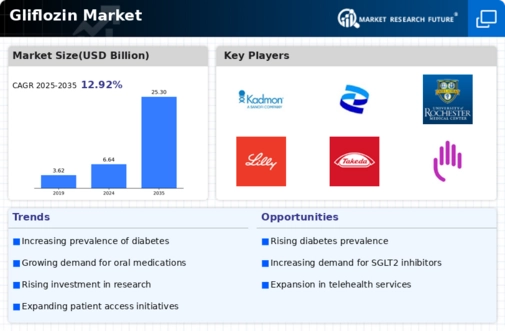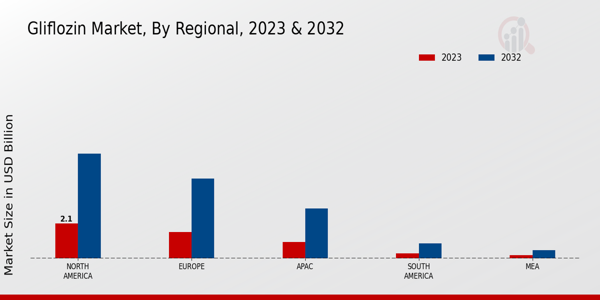Market Growth Projections
The Global Gliflozin Market Industry is projected to experience substantial growth over the next decade. With a market value of 6.64 USD Billion in 2024, it is anticipated to reach 25.3 USD Billion by 2035. This growth trajectory indicates a compound annual growth rate of 12.92% from 2025 to 2035. Such projections reflect the increasing demand for effective diabetes management solutions and the ongoing advancements in gliflozin therapies. The market's expansion is likely to be driven by a combination of factors, including rising diabetes prevalence, regulatory support, and enhanced patient education.
Rising Prevalence of Diabetes
The increasing incidence of diabetes globally is a primary driver for the Global Gliflozin Market Industry. As of 2024, the number of adults diagnosed with diabetes is projected to reach approximately 537 million, a figure that underscores the urgent need for effective treatment options. Gliflozins, as a class of medications, have shown efficacy in managing blood glucose levels while also providing cardiovascular benefits. This growing patient population is likely to propel the market, contributing to an estimated market value of 6.64 USD Billion in 2024, with expectations of reaching 25.3 USD Billion by 2035.
Advancements in Drug Development
Innovations in pharmaceutical research and development are significantly influencing the Global Gliflozin Market Industry. The introduction of new gliflozin formulations and combination therapies enhances treatment options for patients, potentially improving adherence and outcomes. For instance, recent studies have indicated that newer agents in this class may offer improved renal protection, which is crucial for diabetic patients. As these advancements continue, they are expected to stimulate market growth, with a projected compound annual growth rate of 12.92% from 2025 to 2035, reflecting the industry's commitment to addressing unmet medical needs.
Regulatory Support and Approvals
Regulatory agencies are increasingly supportive of gliflozin medications, which is a crucial factor for the Global Gliflozin Market Industry. Recent approvals for new gliflozin products and indications have facilitated broader access to these therapies. For example, the approval of additional indications for existing gliflozins has expanded their use in various patient populations, including those with heart failure and chronic kidney disease. This regulatory environment is likely to enhance market penetration and foster growth, as healthcare providers gain confidence in prescribing these medications.
Increased Awareness and Education
There is a growing emphasis on diabetes education and awareness campaigns worldwide, which is likely to drive the Global Gliflozin Market Industry. Health organizations and governments are actively promoting awareness regarding diabetes management, including the benefits of gliflozin medications. This increased awareness is expected to lead to higher diagnosis rates and treatment initiation, thereby expanding the patient base. As more healthcare professionals become informed about the advantages of gliflozins, the market is anticipated to grow, contributing to the overall market value projected for the coming years.
Emerging Markets and Accessibility
Emerging markets are becoming increasingly important for the Global Gliflozin Market Industry. As healthcare infrastructure improves in regions such as Asia-Pacific and Latin America, access to diabetes medications, including gliflozins, is expanding. This trend is likely to be supported by government initiatives aimed at improving healthcare access and affordability. The growing middle class in these regions is also expected to drive demand for innovative diabetes treatments. Consequently, the market is poised for significant growth as these regions contribute to the overall market expansion.















